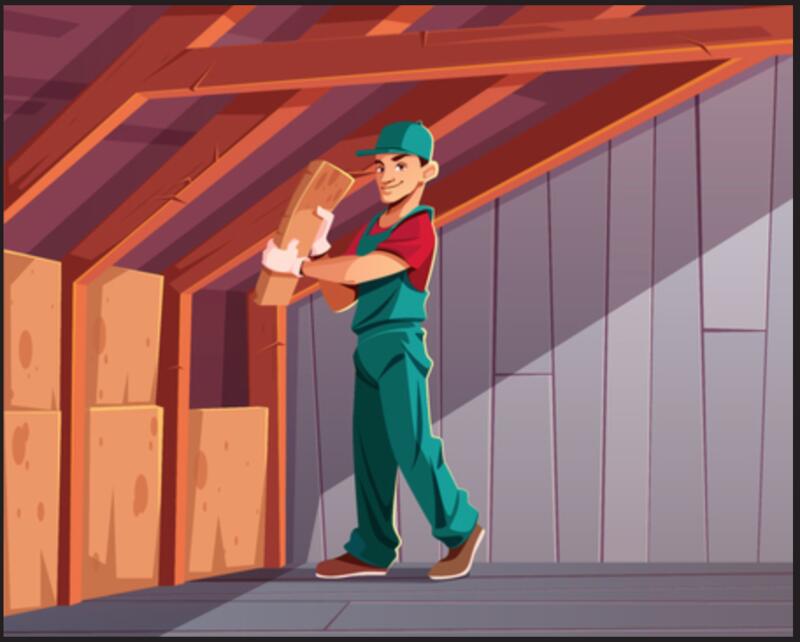
Insulation of buildings in Geneva and Vaud | Introduction
Building insulation is about reducing the heat exchange between an enclosure, the interior of a building, etc., and the outside environment (thermal insulation). If you optimise the latter, you reduce heating costs in winter and cooling costs in summer. Insulation also ensures thermal comfort during heat peaks. In addition, it reduces the environmental impact of your property.
In this article, we will look at several key points in understanding thermal insulation. First, a physics sidebar introduces the subject from a scientific point of view. Then, several insulators will be presented in order to understand their characteristics and which ones are suitable for your building. Finally, thermal insulation is placed in the context of the French-speaking part of Switzerland, notably the cantons of Geneva and Vaud and the cities of Geneva, Nyon, Morges, Lausanne, Yverdon-les-bains, Vevey and Montreux.
Heat loss from buildings
Why do buildings lose heat?
A difference in temperature between two environments creates a movement of heat. The heat will naturally want to move towards the cold. The environment wants to impose its temperature on the building. But the building is equipped with a boiler and a thermal envelope and can therefore impose its own temperature: usually 20°C. When the temperature difference between the inside and the outside is large, like in summer: 30°C or in winter: -10°C, this is where the heat loss is significant. With the help of renovations and more specifically with the help of insulation we can minimise these heat exchanges.
HPE, THPE, Minergie, Minergie-P, Minergie-Eco renovations have in part exactly this objective.
Thermal bridges
What are thermal bridges and how can they be avoided?
According to the SIA 180 standard, the heat-insulating components of the building envelope (walls, ceilings and floors, as well as windows and doors) must completely enclose the heated space [...]. The construction method chosen must avoid thermal bridges as far as possible.
A good analogy for the behaviour of heat flows is the flow of water. Water always flows spontaneously downwards, the same applies to heat, it always 'flows' from hot to cold. Water will also choose the easiest path, where there is the least resistance. It's the same with heat! It will naturally escape where the thermal resistance is lowest. For example: window openings, floor slabs, the foot of the façade, etc. etc. Figure 1 shows the thermal bridge at the head of the slab, i.e. the thermal flows that diffuse into a slab resting on a wall. The slab insulation (in blue) and the wall insulation (in yellow) are also distinguished. (Roulet & Roulet, 2004)

Figure 1: Material thermal bridge: slab on load-bearing wall with internal insulation: (a) cross-section: (b) heat flow lines, Source: (Roulet & Roulet, 2004)
In figure 2, we see that both insulation methods are possible. So how can thermal bridges be avoided? A forward-looking design is to install external insulation. This often avoids most thermal bridges. It also improves thermal comfort in summer and optimises passive solar gains in winter (Roulet & Roulet, 2004).
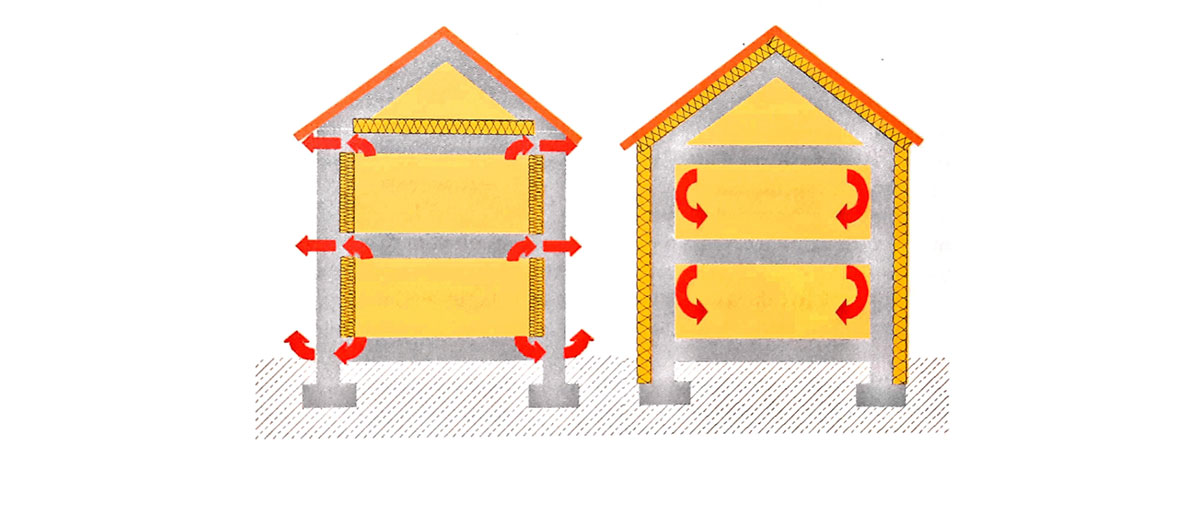
Insulating materials
Above all, it should be borne in mind that the lower the lambda λ value (the ease with which a material allows heat to pass through), the better the insulation. Similarly, the higher the thermal resistance (R), the better the thermal performance.
What are the different materials available for insulation?
There are several insulating materials in the construction field. The most commonly used are
- Inorganic fibrous materials or mineral wools (glass fibre and rock wool)
- Organic foams (polystyrene, polyurethane, PVC, etc.)
- Woody materials (lightweight wood, straw batting, lightweight fibreboard)
What are the best insulators?
Answering this question is not that easy! The complexity of an objective answer depends on many variables that affect a multitude of subjects, such as
- Their insulation capacity and winter comfort
- The ability to diffuse and phase out the heat wave for summer comfort
- Their cost on the Swiss market
- Grey energy, i.e. the amount of CO2 spent in their production
- Their environmental impact for production, installation, recycling and in case of fire
- Fire retardant capacity, i.e. fire resistance
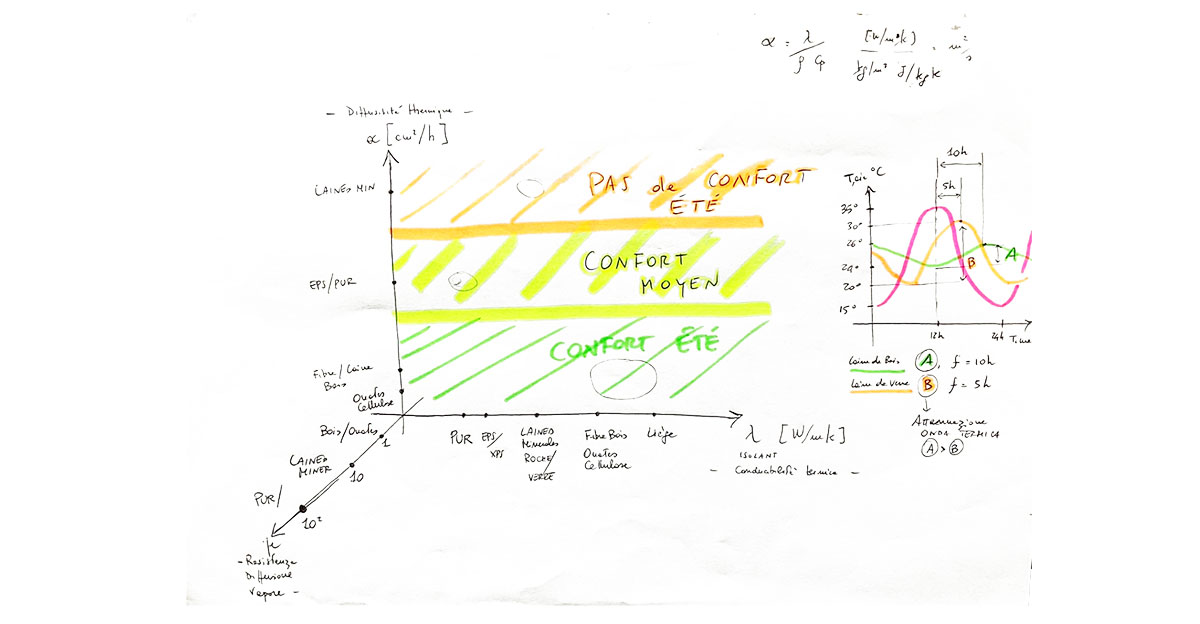
Santandrea Expert Energie - Comparative analysis of insulating materials for summer / winter comfort. Wood wool guarantees the best summer comfort compared to mineral wools and polystyrene
Let's try to get some clarity with a description of each insulator
Mineral wool
Classically, these are glass wool and rock wool.
They have a very good performance/price ratio and good fire resistance.
However, their environmental balance is not very favourable (high grey energy due to the fusion of the sand or rock and in terms of 150 to 250 kWh / m3).
Their low density and high thermal diffusivity offer a low phase shift of the summer heat wave and thus a poor summer comfort.
In Switzerland, these products are mainly produced locally (Flumoroc, Isover, Kneuf, among others). Their price is rather stable on the Swiss market. The variation due to the Covid and 2022 crisis has not strongly affected these products.
In summary, mineral wools are recommended for the insulation of walls, cellar ceilings and facades. They are not recommended for attic slabs or roofs as summer comfort is limited.
Polyurethane insulation
Synthetic insulation made from petrochemicals: these are polystyrene (expanded or extruded, XPS, EPS, etc.) and polyurethane (PIR, PUR).
They are also inexpensive and are the most efficient insulators.
The insulation is not sensitive to moisture at all. They can therefore be used for external insulation.
They also have good compressive strength (under slab insulation).
On the other hand, their very low density implies a very low phase shift and poor summer comfort.
Their ecological balance is very unfavourable (between 450 and 850 kWh / m3) and the vapours released in the event of fire are highly dangerous.
Natural Insulation
Those of vegetable origin: wood wool, hemp, linen, cotton, cork, straw.
Those of animal origin: sheep's wool, goose feathers.
The most widespread are certainly wood wool and cellulose wadding. The latter is made from recycled fabrics. The thermal performances are good and these insulators are generally quite dense, thus a very good summer comfort.
They also allow natural evacuation of water vapour and have the advantage of a very favourable environmental balance.
On the other hand, their price can be higher, except for recycled products.
They are highly recommended for roof and loft slab insulation to ensure summer as well as winter comfort.
The Subsidies for insulation
Is building insulation subsidised at Switzerland Romandie ?
Several Subsidies exist for the insulation of buildings in the canton of Vaud and Geneva:
They are granted for the improvement of the thermal insulation of the facade, roof, walls and floor to ground. The improvement of the insulation coefficient is also subsidised. (02. Applying for a grant for thermal insulation - M01 | VD.CHs. d.)
Variants 2 and 3 allow the inclusion of work that is not included in measure M01, such as the replacement of windows, doors or the insulation of elements against unheated rooms such as attic floors and cellar ceilings. (03. Claiming a bonus for the overall renovation of the building envelope (in addition to measure M01) - M14 | VD.CHs. d.)
A further bonus is also granted in addition to the M01 measure as soon as the building can achieve MINERGIE® or MINERGIE®-P certification.04. Claiming a bonus for achieving the MINERGIE® standard (in addition to measure M01) - M15 | VD.CHs. d.)
For the canton of Geneva there is the subsidy: "Walls and floors against the outside and/or buried up to 2 m". This subsidy is granted to insulate opaque walls and floors against the outside air and also walls and floors against the ground (cannot be combined with M-10 to M-13) (Thermal insulation / Walls and floors against the outside air and/or buried up to 2m | Genergies. d.)
This grant is given for the improvement of thermal insulation of opaque roofs in Geneva. (Thermal insulation of the roof | Genergies. d.)
Conclusion | Insulation of buildings in Geneva and Vaud
Building physics is about understanding how heat is lost in a building. Heat loss from a building determines your heating bills. This can be reduced considerably with insulation work. Insulation helps to overcome this energy loss.
There are several types of insulation and each has a specific application in the renovation of the building stock. Insulation materials are comparable to each other. They differ in their thermo-hygrometric properties, costs, grey energy and environmental impact.
Subsidies is available to support such efforts.
Renovating your home or office is a climate-friendly way to save energy and improve Switzerland's energy supply.
Our services in all this
You've read our article, done some more research, had a good night's sleep and decided it's time to get started... and you decide to use our services!
If you need to have a CECB/CECB+ to meet a grant condition, you can call on our certified expert who will issue the certificate.
If you want to avoid complexity and bureaucracy, you can opt for our grant application handling service.
And finally, if you want to be accompanied from the end of this article, from the period of reflection to the completion of the work, then contact us to benefit from our expertise, our experience and, let's face it, our passion.
Bibliography
- Applying for a grant for thermal insulation-M01 | VD.CH. (n.d.). Retrieved 22 April 2022, from https://www.vd.ch/prestation-detail/prestation/02-demander-une-subvention-pour-lisolation-thermique/?tx_vdprestations_pi4%5Bcontroller%5D=Prestation&tx_vdprestations_pi4%5Baction%5D=show&cHash=3dfbd7943d4df2db8b32bb0f43077c98
- Claiming a bonus for the overall renovation of the building envelope (in addition to measure M01)-M14 | VD.CH. (n.d.). Retrieved 22 April 2022, from https://www.vd.ch/prestation-detail/prestation/03-demander-un-bonus-pour-renovation-globale-de-lenveloppe-du-batiment-en-complement-a-la-mesure/?tx_vdprestations_pi4%5Bcontroller%5D=Prestation&tx_vdprestations_pi4%5Baction%5D=show&cHash=fecc6d0f5313b044d27bc91dfa3c4acc
- Claiming a bonus for achieving the MINERGIE® standard (in addition to measure M01)-M15 | VD.CH. (n.d.). Retrieved 22 April 2022, from https://www.vd.ch/prestation-detail/prestation/04-demander-un-bonus-pour-latteinte-du-standard-minergie-en-complement-a-la-mesure-m01/?tx_vdprestations_pi4%5Bcontroller%5D=Prestation&tx_vdprestations_pi4%5Baction%5D=show&cHash=89c7e4d3d2d20d4edef541707e09b1da
Thermal insulation / Walls and floors against the outside and/or buried up to 2m | Genergie. (n.d.). Retrieved 22 April 2022, from https://www.ge-energie.ch/isolation-thermique-murs-et-sols-contre-exterieur-etou-enterres-jusqua-2m
Thermal insulation of the roof | Genergie. (n.d.). Retrieved April 22, 2022, from https://www.ge-energie.ch/isolation-thermique-du-toit
Roulet, C.-A., & Roulet, C.-A. (2004). Health and indoor environmental quality in buildings. Presses Polytechniques et Universitaires Romandes.
Martin Borkovec
martin.borkovec@ik.me
Master Energy and Environment (HES-SO)
Company: Santandrea Energie Expert
Date: 22.04.2022
One Comment
Comments are closed.

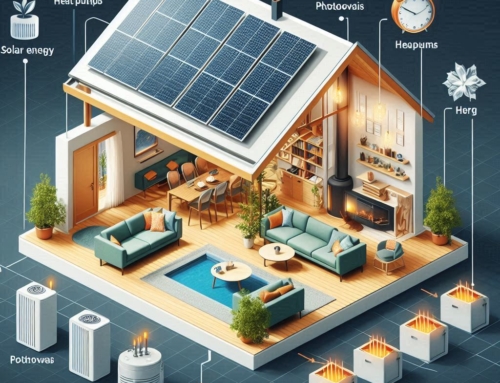

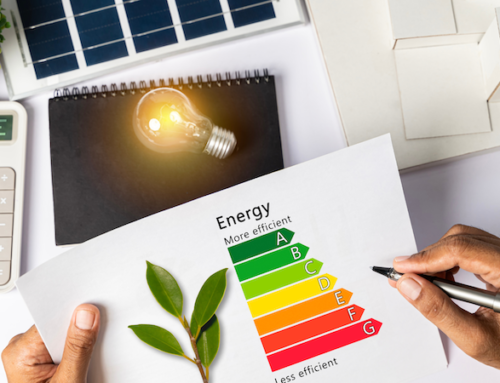
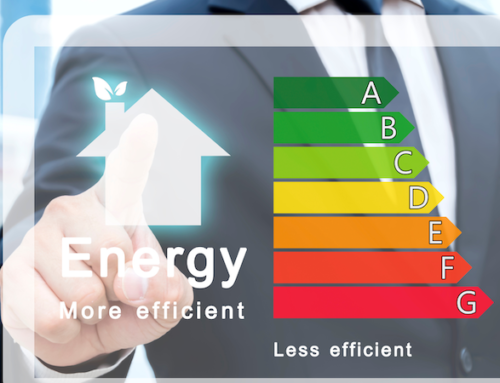
Thankjs very nice blog!